This is two questions, no?Bonus question...
How come there are virtually no ten year old kids who need to have shit this fucking obvious explained to them and virtually all glider divers are totally incapable of getting the slightest grasp on this concept no matter how many decades worth of broken arms and necks they hear about, see, and experience?
landing
-
Steve Davy
- Posts: 1338
- Joined: 2011/07/18 10:37:38 UTC
Re: landing
- Tad Eareckson
- Posts: 9161
- Joined: 2010/11/25 03:48:55 UTC
Re: landing
Arguably.
But it/they can be satisfied with one answer. Something to the effect of:
Because as kids mature and enter into hang gliding training they stop thinking for themselves and start worshipping their instructors and the culture.
Of course that's also arguably two answers.
P.S. Experiment...
- Train chimps to fly hang gliders and land by going upright at a hundred feet and land on their feet.
- Let them watch people alternately approaching upright intending foot landings and prone intending wheel landings.
- Record any changes in behavior.
But it/they can be satisfied with one answer. Something to the effect of:
Because as kids mature and enter into hang gliding training they stop thinking for themselves and start worshipping their instructors and the culture.
Of course that's also arguably two answers.
P.S. Experiment...
- Train chimps to fly hang gliders and land by going upright at a hundred feet and land on their feet.
- Let them watch people alternately approaching upright intending foot landings and prone intending wheel landings.
- Record any changes in behavior.
- Tad Eareckson
- Posts: 9161
- Joined: 2010/11/25 03:48:55 UTC
Re: landing
http://ozreport.com/forum/viewtopic.php?t=7671
Gallery Of Pain
How 'bout we go to the dunes and have a pylon course competition? I'll fly prone on the basetube and you fly upright and effect your turns by pushing down on the top of the appropriate downtube.
2. Remember the "landing" which prompted this discussion?
http://www.youtube.com/watch?v=vaTu5Y4WBdY
04-2809
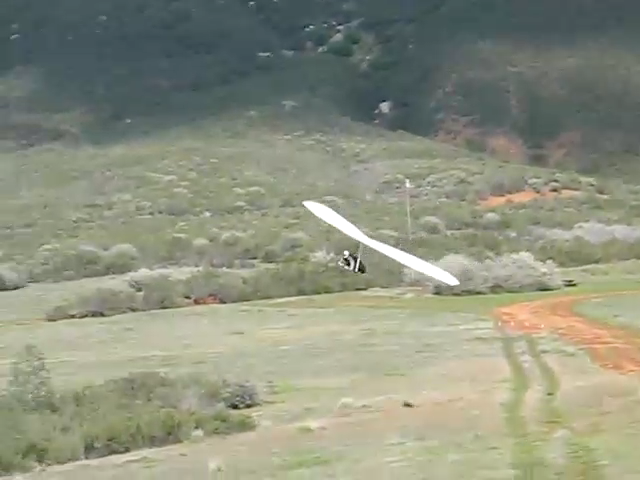
05-3001
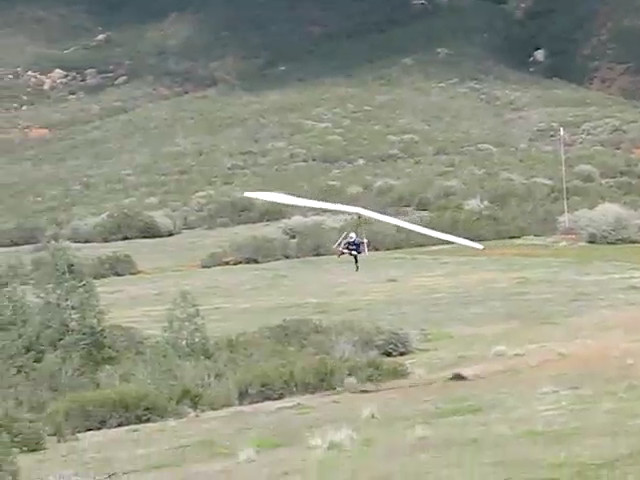
06-3104
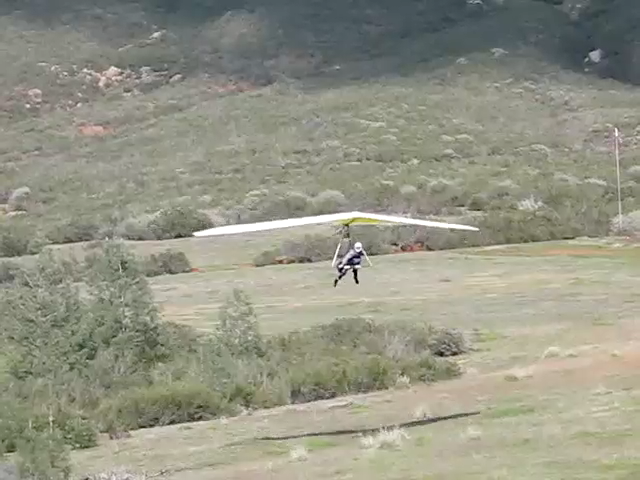
07-3205
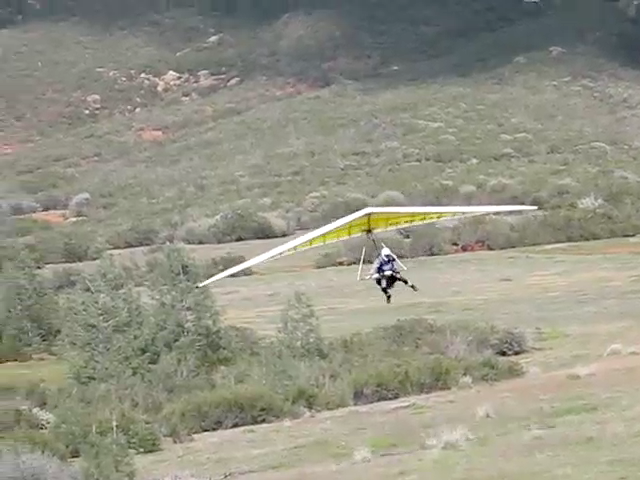
08-3304
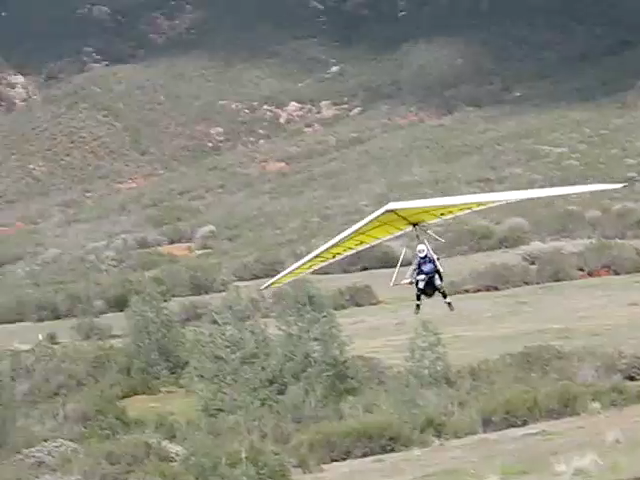
11-3505
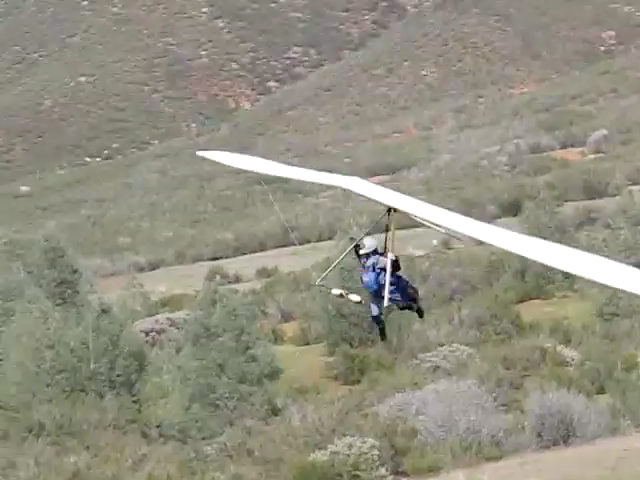
13-3602
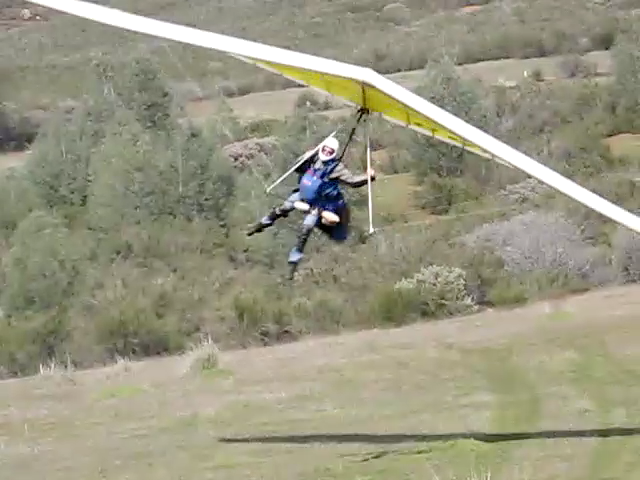
18-3704
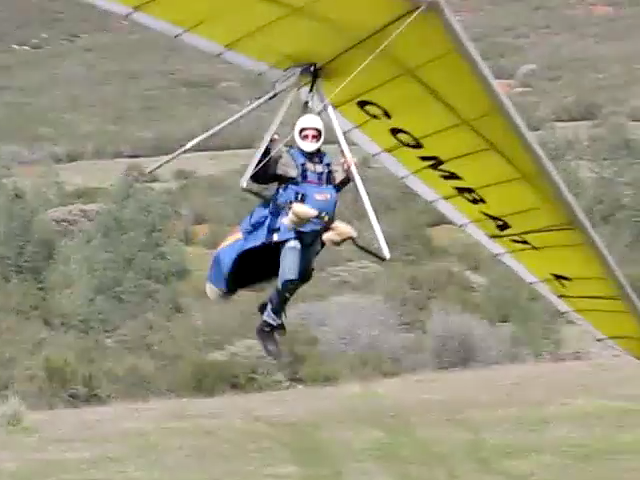
21-3708
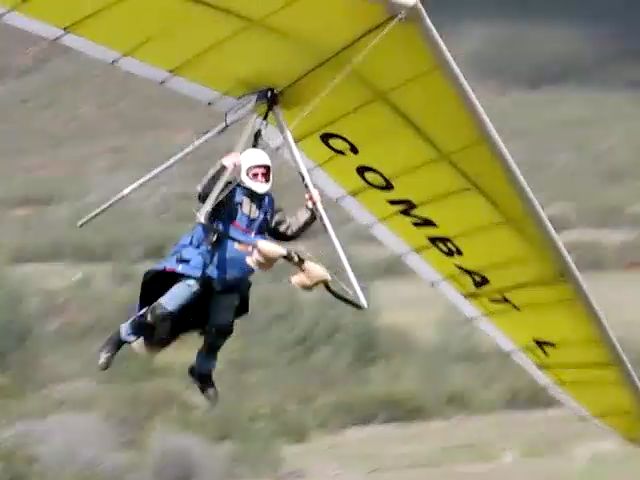
24-3810
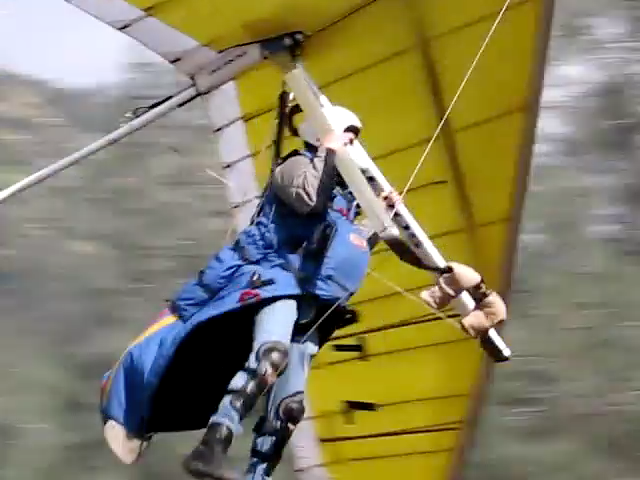
F*** you Bob!
unhooked take off clip
2. As in normal prone configuration, it's not where you shoulders end up that matters. It's where your hips end up that tells you what should start happening. And if your view of the hips is cut off just look at how the suspension is (or isn't) angled.
1. When Kunio launched unhooked and climbed into the control frame (feet on the basetube) his center of mass was almost undoubtedly still behind the control frame. But he needed to - and didn't - relax and allow himself to hang way back to get the glider back down to a normal trim speed. As it was he was going like a bat outta hell, hugging and oscillating down the slope in an unsustainable manner. He needlessly died twice that afternoon.
2. If you're flying too slowly for your situation it's because your arms are in a much better configuration to get broken than pull in. That's your limiting factor.
2. DO NOT do a long straight final.
- You can fuck up your glide estimate and/or get your glide fucked up by Ma Nature. DO NOT - repeat - DO NOT risk getting out of range of the field. Trees between you and the field can suddenly start growing in a manner you will never see while standing on the ground.
- Do a downwind, base, and final. Err on the high side. Do an extra base if you err too much. Altitude is almost always easier to get rid of than it is get back.
- Even if the landing area is pretty much unlimited, long straight finals are boring. Pretend you're coming into a tight field so you can practice the low hard turns you need to get into a tight field.
2. And if you fuck up the transition it's not likely to be that B an F'ing D.
Gallery Of Pain
Steve Davy - 2012/01/16 06:38:55 UTC
Hi Christopher,
I am a little confused by your post. Are you saying that you believe a pilot has more roll authority when upright, as opposed to fully prone with both hands on the base tube?
Steve
And you do this? You grab a downtube with both hands and push down on it with everything you've got when you really wanna make or stop a turn?Christopher LeFay - 2012/01/16 07:13:39 UTC
Absolutely, Steve; upright, all weight may be depended directly from the down tube, effecting the strongest possible roll input with the full weight of the pilot brought to bear - and without the lag or counter correction of the prone pilot belling to the low side.
How 'bout we go to the dunes and have a pylon course competition? I'll fly prone on the basetube and you fly upright and effect your turns by pushing down on the top of the appropriate downtube.
Yeah, I'll go with all that.Alan Deikman - 2012/01/16 16:33:03 UTC
I don't get this. On the base tube you have more leverage - your force input is further away from the fulcrum. With your hand on the down tube you can make a smaller motion to get the same control input, but it takes correspondingly more force. You can also make a larger control input which is why you move your hands up to flare. You are closer to the fulcrum. That makes it more difficult for many people to do for roll input.
You don't suddenly have more weight going upright. You can "waste" your weight by cross-controlling either prone or upright (done it many times!) and you can argue it is easier to do that prone versus upright - but your weight it is the same.
No but... Don't forget about the issue of speed and its effect on roll control.That said most hang gliders seem to be perfectly controllable under most conditions from the down tubes. I always thought that the reason we go upright is to a) get our hands high enough (closer to the fulcrum) to do a full flare, and b) land on our feet. Not because it is easier to roll. Is that wrong?
Only if you don't know how to fly upright AND are immune to the laws of physics.Christian Williams - 2012/01/16 16:49:21 UTCOnly if you don't know how to fly upright.A pilot flying prone with both hands on the base tube is advantaged over those flying upright.
Full confidence - one of the most deadly things you can have in aviation.It's a skill worth practicing and full confidence comes.
Maybe it's not a real great idea to be spending a lot of time slow above ground effect but low.Christopher LeFay - 2012/01/17 07:09:26 UTC
A few points. Roll rate and force aren't constant; the input force required to effect a radical turn at high speed while climbing out of a dive (say, a wing-over) is considerably less than what is needed to counter a strong lifting wing at lower speed (launch, landing).
Are strength limitations significant issues with respect to landing problems?The prone flying posture, with arms L'ed toward our head, extended more than contracted, favors high twitch over low twitch muscle. The impact will depend on both the strength of the pilot, the strength of the opposed lifting force, and inertia.
Again... Is this an actual issue in actual landings?Prone, coming out of a dive, I can rotate the glider around my center of mass - something I could never do upright! There are times when I might very much need to do that on approach - but is not the same as fighting a lifting/falling wing without the luxury of altitude at low speed.
Who cares? There are virtually no tandem gliders in which the Pilot In Command lands upright and there are virtually no incidents involved in tandem landings. You wanna see tandem incidents? Start having them land like solos.Alan and I likely differ in strength - still, ballast us to equality and hook us in tandem: as soon as we are airborne, I'll cling to one down tube upright, while Alan shifts his weight in the opposite direction prone; any bet on which way the glider will turn?
Me too.Bill Cummings - 2012/01/17 20:34:26 UTC
It will turn Alan's way!
I dunno Jim...Jim Gaar - 2012/01/17 22:14:10 UTC
PILOT 1Followed by:A pilot flying prone with both hands on the base tube is advantaged over those flying upright.
Pilot 2OMG how many times does any one pilot have to say this? MANY... I'm impressed by how many pilots just plain NEVER seem to spend time upright in the control frame learning to fly.Only if you don't know how to fly upright. It's a skill worth practicing and full confidence comes.
Thanks Christian!
Sounds like at least SOME new pilots are getting adequate doses of this kind of experience.Shane Nestle - 2010/06/26
Dan and I alternated doing compressions over the next forty minutes until a paramedic arrived. The paramedics immediately got permission to stop CPR from a doctor via cell phone and did an EKG to confirm no signs of life. At that point the rescue became a recovery. The Life Flight helicopter ended up doing a basket extraction using night vision goggles.
Analysis: From my perspective, the entire accident was pilot error. The problem began when he initiated his turn. Being that John was still very new to flying in the prone position, I believe that he was likely not shifting his weight, but simply turning his body in the direction he wanted to turn.
Don't overdo things.Rdp_au - 2012/01/18 03:50:42 UTC
With utmost respect...
On The DAVIS SHOW? No way, dude. And, even if there were, Davis would've stepped in and cleared things up by now, right?...I would suggest there's some confused thinking here.
No. If it just acts through the hang point the glider will have an opposite reaction. It's gotta act through the wires as well.Control input to a glider comes from the pilot generating a torque acting through the hang point of the glider.
By pulling on the control frame which is braced by / pulls on the wires.This is achieved by displacing the mass of the pilot from an equilibrium position where no torque is generated.
The magnitude of this torque is a function of the extent of the displacement and the mass of the pilot. The pilot's location and orientation (hang, prone, sitting in the A-frame) affects the leverage available to create the displacement and therefore the perceived effort to do so. However, if the displacement is the same, the control input to the glider is the same, regardless of this perceived effort. This is true for both inertial (steady state) and non-inertial (accelerating, as in pulling out from a dive or in a turn) frames of reference.
The glider will always rotate about the combined centre of mass of the pilot and glider, regardless of how the manoeuvre is accomplished.
If you both have the same mass, and displace yourselves the same amount, then the glider will not turn at all, as the net torque will be zero.
The ones who aerotow all do.Steve Davy - 2012/01/18 05:57:07 UTC
Wow, thanks for the great info. Next time I get into some turbulent conditions I'll be sure to rotate upright and get my hands on the down tubes in order to gain maximum control authority.
Funny, I don't see ANY pilots going upright when things get choppy. Maybe they don't read the OZ Report.
How often are landings being fucked up by Alan, inertia, or the Air Force?Christopher LeFay - 2012/01/18 07:46:47 UTC
Rdp_au,
In the hypothetical, I'm not contending that we have equal displacement: mine would be greater - and sustained with greater authority. My position would be far easier to maintain, and less susceptible to being overwhelmed by either Alan, inertia, or air forces.
And, quite often, you can leave everything in context and be equally effective.Ridgerodent,
Sure - you can remove context to make something you don't have experience with seem inane.
Actually Christopher, I virtually always see all the shit that typically and routinely happens in the LZ occurring precisely BECAUSE people go upright.Low speed, low altitude, turbulence, with the need for instant, authoritative roll from a posture that keeps the brain-bucket away from the pavement - and you say you've never seen anybody in that context go upright? That is incredible.
1. Looked at in its entirety - no. But when you look at components within the glider/pilot system - yes. When you're initiating or countering a turn you're torqueing the control frame one way or another. And that torque is gonna be transmitted through the sidewire of the wing you're trying to lower. And you're gonna be very well aware of the strain you're taking and holding until things stabilize where you want them to.Rdp_au,
There are other forces at play; with twice the mass of the glider, my inertia at speed changes the dynamic - as does air flow. The center of rotation is not always appreciably the combined center (for example, rotating the glider at the apex of a steep climb-out). When I hang directly from the down tube, am I turning the glider via torque - or have I essentially moved the center of mass? Torque expresses a relationship of force to distance. Can an asymmetrically weighted wing be said to be exerting torque over itself?
2. Remember the "landing" which prompted this discussion?
http://www.youtube.com/watch?v=vaTu5Y4WBdY
04-2809

05-3001

06-3104

07-3205

08-3304

11-3505

13-3602

18-3704

21-3708

24-3810

http://www.ushawks.org/forum/viewtopic.php?f=2&t=933Steve Davy - 2012/01/18 08:16:26 UTC
Not so incredible, I just lack the skills to express myself clearly on internet forums. I do the best I can and try to be clear. I just need more practice.
F*** you Bob!
Try to get a few pointers from this "Nobody" dude. He seems to do OK getting his points across in a clear and concise manner.Nobody - 2012/01/13 09:55:22 UTC
Is that clear enough for you to understand?
Dude is flying around in the Owens valley, gets rocked by some big air, should he rotate up and get his hands on the down tubes for more control?
Tormod Helgesen - 2012/01/18 08:47:35 UTC
Oslo
I have heard that hanging from the downtube will actually create less roll because the keel won't shift as much.
Best to not believe everything you hear in this sport.Zack C - 2010/12/13 04:58:15 UTC
I had a very different mindset too back then and trusted the people that made my equipment. Since then I've realized (largely due to this discussion) that while I can certainly consider the advice of others, I can't trust anyone in this sport but myself (and maybe the people at Wills Wing).
Yeah, but that's all we've got. Unless you wanna hook up to a towline - then you can attain absolutely astounding roll rates with no effort whatsoever.Rolling a hangglider with torque alone is a slow process.
Bit of an understatement, don't you think?Robert Seckold - 2012/01/18 10:09:00 UTC
Are you talking about hanging off the uprights with your weight or using the uprights to control your glider whilst upright?
I am no scientist...
You're not lowering your center of gravity. You're pivoting your body around it....but I would think going upright and lowering your centre of gravity would give you better authority over your glider. Similar to hanging closer to your base bar gives you better control.
http://ozreport.com/forum/viewtopic.php?t=15337Tormod Helgesen - 2012/01/18 10:42:23 UTC
I was talking about hanging from the arms on the downtubes, one shouldn't do this of course but some do, mostly beginners on the training hill.
unhooked take off clip
And occasionally people who don't believe in gremlins unhooking their harnesses during the five to thirty meter walk to launch and only redo their checks if their launch procedures are interrupted.Tormod Helgesen - 2010/02/13 17:08:06 UTC
I don't believe in gremlins unhooking my harness while walking to launch (usually 5-30 meters) and if my launch is interrupted I redo my check.
And for people who don't believe in gremlins it can get extremely low and forward. And sometimes the center of gravity of the body gets so low that it ceases to have any effect whatsoever on the control of the glider.The center of gravity of the body is the same in any position as long as you aren't hanging from your arms.
1. The shoulders don't end up between the downtubes - they end up behind them.That and muscular strength aside, going upright reduces roll authority simply because the displacement of the body is less, remember the downtubes is angled and gets narrower where the shoulders ends up.
2. As in normal prone configuration, it's not where you shoulders end up that matters. It's where your hips end up that tells you what should start happening. And if your view of the hips is cut off just look at how the suspension is (or isn't) angled.
Which you will be.To get equal displacement as when prone you have to be behind the control frame...
Not necessarily and not primarily because you're behind the control frame....and then you are flying too slow...
1. When Kunio launched unhooked and climbed into the control frame (feet on the basetube) his center of mass was almost undoubtedly still behind the control frame. But he needed to - and didn't - relax and allow himself to hang way back to get the glider back down to a normal trim speed. As it was he was going like a bat outta hell, hugging and oscillating down the slope in an unsustainable manner. He needlessly died twice that afternoon.
2. If you're flying too slowly for your situation it's because your arms are in a much better configuration to get broken than pull in. That's your limiting factor.
If you want/need more speed and are pulled in as much as is physically possible - yes....and have even less control.
Yes.The fix is easy...
1. No. Stay prone with your hands on the freakin' basetube....do a approach that brings you into a long straight final...
2. DO NOT do a long straight final.
- You can fuck up your glide estimate and/or get your glide fucked up by Ma Nature. DO NOT - repeat - DO NOT risk getting out of range of the field. Trees between you and the field can suddenly start growing in a manner you will never see while standing on the ground.
- Do a downwind, base, and final. Err on the high side. Do an extra base if you err too much. Altitude is almost always easier to get rid of than it is get back.
- Even if the landing area is pretty much unlimited, long straight finals are boring. Pretend you're coming into a tight field so you can practice the low hard turns you need to get into a tight field.
Go upright AFTER the gradient. That way you'll never be wishing you had more of the glider's speed range available to you to punch through the gradient and whatever other invisible crap may be lurking below....go upright before OR after the wind gradient...
1. IF you really wanna do "THE" transition do it AT trim 'cause the glider's a lot less likely to do anything amusing when you take a hand off the basetube....and do the transition near trimspeed because the downtube is at your shoulder and not behind you.
2. And if you fuck up the transition it's not likely to be that B an F'ing D.
- Tad Eareckson
- Posts: 9161
- Joined: 2010/11/25 03:48:55 UTC
Re: landing
http://ozreport.com/forum/viewtopic.php?t=7671
Gallery Of Pain
2. So after one has mastered this skill all of his upright approaches and landings should be pretty much flawless, right?
You've got your legs and feet where you need them:
http://www.youtube.com/watch?v=tkElZMhpmp0
And you've got your hands up high on the downtubes for really good pitch control:
Before and After
http://www.youtube.com/watch?v=7zzMbdtOhAk
Sparkozoid - 2011/11/27
dead
14-00725
http://farm4.staticflickr.com/3859/14423696873_f1326e2320_o.png
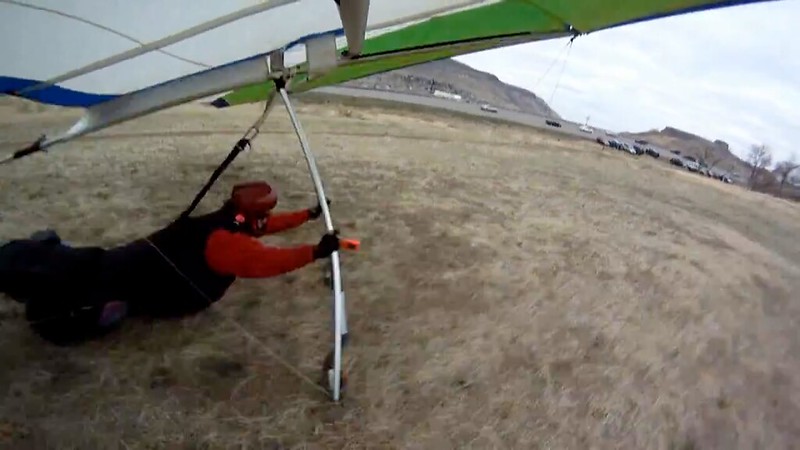
14-00725
http://farm4.staticflickr.com/3859/14423696873_f1326e2320_o.png

You don't really need wheels while you're flying anyway.
No wheels, 130 pound Greenspot weak link, full face helmet...
http://www.youtube.com/watch?v=bTa6XL16i0U
SCFR Day 2 Highlights
LAGlide - 2011/09/20
dead
021-02800
http://live.staticflickr.com/3848/14609177375_f8c224836d_o.png
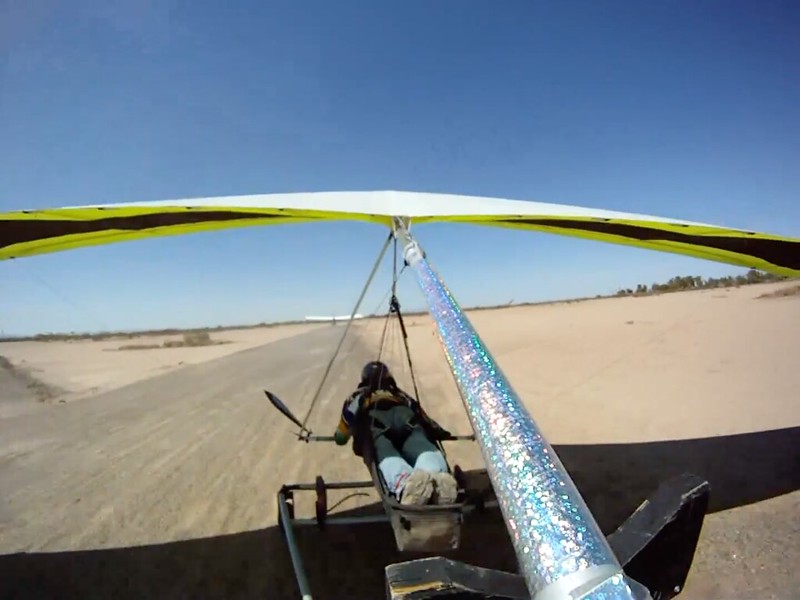

http://live.staticflickr.com/5529/14422573378_5385a9a99a_o.png
057-03703
You and Jonathan good friends?
2. So because YOU haven't YET experienced a speed range issue upright there's just no possibility of you encountering one, right?
3. Have you READ about a worst case scenario - à la Ron Smith - or even thought about one in which you COULD experience a speed range issue? Just kidding.
4. Have you ever experienced the right combination of factors in which your helmet or parachute became an issue?
2. You can ALWAYS choose your time to launch (or not).
3. On a glider, once you've left or been deprived of lift, you tend not to be able to choose your time to land - outside of some fairly narrow parameters.
4. If you get hit by nasty enough shit on landing you wanna be prone - and landing on your feet will be way down on your list of priorities.
Gallery Of Pain
Yeah. And in this case you can actually watch the progression in real time.Jim Gaar - 2012/01/18 15:31:50 UTC
Stupid is as stipid does...
Maybe, in this case, meaning with zero supporting evidence. Which would mean, essentially, no.In some cases YES, maybe.Dude is flying around in the Owens valley, gets rocked by some big air, should he rotate up and get his hands on the down tubes for more control?
1. Who is "we"?However we are talking about "practicing" up high so one can master the skill and then use it when needed down low.
2. So after one has mastered this skill all of his upright approaches and landings should be pretty much flawless, right?
Yeah, I'm having a bit of trouble with that approach.Is that so hard to understand?
Well then, crudely speaking, you should be sure it doesn't.Kinsley Sykes - 2012/01/18 16:11:14 UTC
Not sure that going upright lowers (or changes) your center of gravity. Crudely speaking, half of you is lower and half of you is higher, so net, net - no change.
It doesn't help - AT ALL - on LANDING. It MAY help - or hurt - on APPROACH.What is different is that you have a lot more drag due to larger surface area which helps on landing.
And do you NEED to be in the position in which you will ultimately need to be to flare?You are also in the position you will ultimately need to be in to flair...
There are only three things that ever force anyone to transition: tall grass, rocks, and USHGA instructors. And those all of those should be avoided like the plague....so you aren't forced to transition at a bad time.
Yeah. Sure ya can.Finally, if it all goes to crap, you can "crash better" if you are upright.
You've got your legs and feet where you need them:
http://www.youtube.com/watch?v=tkElZMhpmp0
And you've got your hands up high on the downtubes for really good pitch control:
Before and After
http://www.youtube.com/watch?v=7zzMbdtOhAk
Sparkozoid - 2011/11/27
dead
14-00725
http://farm4.staticflickr.com/3859/14423696873_f1326e2320_o.png

Ask Christopher if he FEELS like he has more control upright pushing down at the top of a downtube or just THINKS he does after he finishes running everything through his math.Personally, I feel like I have more control the more prone I am.
At what point in a turbulent approach do you become certain that you're through the worst of the junk?Having said that if it's a turbulent approach, I usually opt for the "one up, one down" method until I get through the worst of the junk.
Great!I don't fly with wheels...
14-00725
http://farm4.staticflickr.com/3859/14423696873_f1326e2320_o.png

You don't really need wheels while you're flying anyway.
So does Sparky. Notice the way he didn't get a concussion or broken jaw on that landing?...I do have a full face helmet...
Of course you do!!! It's the perfect weak link for YOUR flying weight - just as it is for everyone else's. Never breaks when you don't need it to and always breaks before you can get into too much trouble. Besides, when you're flying with the Lookout equipment you undoubtedly use, it makes a really great instant hands free release - as long as you're over 250 feet (assuming we can rely on Marc's figure)....use a greenspot weaklink when I aerotow...
Me too - whoever he is....and I am OK with a guy on my rear wires at Lookout and Hensons.
No wheels, 130 pound Greenspot weak link, full face helmet...
http://www.youtube.com/watch?v=bTa6XL16i0U
SCFR Day 2 Highlights
LAGlide - 2011/09/20
dead
021-02800
http://live.staticflickr.com/3848/14609177375_f8c224836d_o.png


http://live.staticflickr.com/5529/14422573378_5385a9a99a_o.png
057-03703
You and Jonathan good friends?
1. How 'bout the right combination of glider, harness, and conditions?Christopher LeFay - 2012/01/18 19:55:25 UTC
Couple points: I don't have any issue flying adequately fast for launching or landing upright "behind the control frame"; it may be that I have yet to encounter the right combination of harness or glider, but I have never experienced any speed range issue upright (though I haven't attempted to fly remarkably fast on a slow wing wing from that position - typically, just diving into a short LZ).
2. So because YOU haven't YET experienced a speed range issue upright there's just no possibility of you encountering one, right?
3. Have you READ about a worst case scenario - à la Ron Smith - or even thought about one in which you COULD experience a speed range issue? Just kidding.
4. Have you ever experienced the right combination of factors in which your helmet or parachute became an issue?
So far, anyway.At launch or approach speeds, including conditions requiring a margin of speed due to instability, I can't imagine a problem easily achieving the needed speed - it doesn't mean there can't be some combination of glider/pilot/harness - but not for me.
How very odd. That's precisely what I'm always trying to avoid whenever I'm landing.As to displacement, I'm not hanging high: when I rotate upright, my hips are near (below?) the base bar, and I can become one with the down tube.
Got any opinions about just how good an idea it is to put a release lever on a downtube on what may instantly become the HIGH side of the control frame?I don't know about ya'll, but I've been spat out by a strong thermals, rolled away and belled to the low side of the control frame.
No shit.Even when flying with good speed, sudden, powerful instability can be overpowering.
Talk to Adam Parer about that assumption.At altitude, it's not much of a big deal...
1. If you get hit by nasty enough shit on launch or landing, there won't be time to do productive struggling from ANY position....if you think it more efficient, fight the roll; if not, roll away until you re-enter. On launch and landing, there is no such option - and there may not be time to struggle out of the low side of the control frame from a prone position.
2. You can ALWAYS choose your time to launch (or not).
3. On a glider, once you've left or been deprived of lift, you tend not to be able to choose your time to land - outside of some fairly narrow parameters.
4. If you get hit by nasty enough shit on landing you wanna be prone - and landing on your feet will be way down on your list of priorities.
Bullshit.As to one-up-one-down - well, the down-side roll authority is deficient...
What "NEED" to transition?...and, if low, the need to transition...
Watch the videos. Damn near any transition is a hazard....is a hazard - as the video above illustrates clearly.
The thing that most commonly dictates a person going upright is a decision to fly without wheels.I use the one-up-one-down posture as a transition, with conditions dictating the altitude to go fully upright at.
How very odd. If I suspect a spanking is coming I stay prone - so I don't rob myself of the options to stuff the bar, maximize roll control, keep my arms from snapping as a consequence of having my hands trapped behind the downtubes, and prevent the power whacking of the top part of my body about the same time the glider's doing a nose plant.If I suspect a spanking is coming, I go upright 'early' - as events may rob me of the option later.
- Tad Eareckson
- Posts: 9161
- Joined: 2010/11/25 03:48:55 UTC
Re: landing
http://ozreport.com/forum/viewtopic.php?t=7671
Gallery Of Pain
http://www.youtube.com/watch?v=vaTu5Y4WBdY
18-3704

2. Let's not forget about towing and Chris Starbuck when we're using the word "we".
2. Make sure you don't ever launch in the worst conceivable (and sudden hairy) conditions. We can do this pretty easily. This is why God gave us ribbons.
3. On 2011/06/05 the late Tim Martin WAS in the worst conceivable conditions at Henson Gap - trying to get down in one piece in a gust front. I one hundred percent guarantee you that he didn't transition to upright, fully or partially, to enhance his roll authority or go one up / one down in preparation for stopping on his feet. I also one hundred percent guarantee you that neither Joe, you, nor anybody in his right mind would've come out of full prone with both hands on the basetube either.
2. When people get hit by nasty shit instantly after takeoff they instantly go prone.
3. All aerotow and platform launches are prone - and problems instantly after takeoff are virtually nonexistent.
4. And when somebody aerotow or platform launches into a thermal or dust devil - because ribbons weren't being used - he NEVER goes upright to better deal with the situation.
- Well, for downwind landings, yeah. Then it really helps to be able to instantly go from safely over stall to zero airspeed - but it's a lot easier to keep yourself out of situations in which you're landing in a tailwind that can't be handled with wheels.
- Downwind TAKEOFFS?
-- Slope launch?
--- Don't.
--- So if you do, you need to be upright because you think that'll decrease your chances of breaking your freaking neck on the rocks below launch? Trust me - it won't.
-- Tow launch?
--- Don't use a weak link which increases the safety of the towing operation. PERIOD.
--- You're in environment which - virtually by definition - is wheel friendly.
- Midairs, gear failure, boulders, launch crew malfunction? Good freakin' luck.
Do you require a helmet, parachute, 1.5 G weak link? Probably never in a flying career. But I don't think I've ever launched in anything twenty or over without having somebody available on a wire - even in the most laminar and otherwise benign of circumstances.
2. If the pilot's judgment, will he sign off a Three if it's ten miles per hour?
3. Will he sign off a rating for someone who has absolutely no freakin' clue what a hook-in check is? (Rhetorical.)
- Gliders can and do tumble and break in violent thermal conditions.
- There's no guarantee that your parachute will keep you from getting killed if your glider tumbles.
- Gliders aren't certified to be flown upright.
- When the shit hits the fan you wanna have everything going for you two seconds ago.
- I don't think flying upright in violent thermal conditions or - for that matter - anywhere above a landing skim is setting a great example.
- Does he ever stay prone and land on his wheels as a kind of advertisement and thought-provoker?
- If Joe really wants to provoke some thoughts...
http://ozreport.com/forum/viewtopic.php?t=4247
Hook in failure in New Zealand
Failure to hook in.
Gallery Of Pain
You seem to remember Greblo's approach to the hook-in issue WAY better than he seems to present it.Christian Williams - 2012/01/18 19:58:00 UTC
Here's the way Greblo looks at it (or how I remember his lectures):
1. And, I submit that a rather large percentage of the bad stuff that happens close to the ground happens BECAUSE we are upright and - in the case of the latter - attempting to become so.We take off and land upright. Therefore, all the bad stuff happens when we are upright. And close to the ground.
http://www.youtube.com/watch?v=vaTu5Y4WBdY
18-3704

2. Let's not forget about towing and Chris Starbuck when we're using the word "we".
1. One up / one down is NOT upright. One up / one down can be prone, upright, or something in between but is usually the latter.Therefore, learn to fly upright in the worst conceivable (and sudden hairy) conditions. (One up / one down is "upright".)
2. Make sure you don't ever launch in the worst conceivable (and sudden hairy) conditions. We can do this pretty easily. This is why God gave us ribbons.
3. On 2011/06/05 the late Tim Martin WAS in the worst conceivable conditions at Henson Gap - trying to get down in one piece in a gust front. I one hundred percent guarantee you that he didn't transition to upright, fully or partially, to enhance his roll authority or go one up / one down in preparation for stopping on his feet. I also one hundred percent guarantee you that neither Joe, you, nor anybody in his right mind would've come out of full prone with both hands on the basetube either.
1. If you NEED to go prone instantly after takeoff you shouldn't have taken off.The alternative, if "more secure prone", is to go prone instantly upon takeoff...
2. When people get hit by nasty shit instantly after takeoff they instantly go prone.
3. All aerotow and platform launches are prone - and problems instantly after takeoff are virtually nonexistent.
4. And when somebody aerotow or platform launches into a thermal or dust devil - because ribbons weren't being used - he NEVER goes upright to better deal with the situation.
What's "the last possible landing moment"? In the worst conceivable conditions you're not worried about showing off a pretty no-stepper so you can hear applause from your idiot friends in the breakdown area. In the worst conceivable conditions you just wanna let the glider take all the impact so you can leave with a slight, temporary limp and go buy another one....and stay prone until the last possible landing moment.
Pure, unadulterated bullshit.In both cases, this requires a change of hand and body position in the worst conceivable conditions near the ground.
I repeat... Pure, unadulterated bullshit.Therefore, in order never to change hand position near the ground, it is necessary to learn to face all the worst moments (thermals, gusts, sinkholes, midairs, gear failure, downwind landings and takeoffs, a lifted wing into boulders and an entire wire ground crew snagged on your jock strap) upright.
- Well, for downwind landings, yeah. Then it really helps to be able to instantly go from safely over stall to zero airspeed - but it's a lot easier to keep yourself out of situations in which you're landing in a tailwind that can't be handled with wheels.
- Downwind TAKEOFFS?
-- Slope launch?
--- Don't.
--- So if you do, you need to be upright because you think that'll decrease your chances of breaking your freaking neck on the rocks below launch? Trust me - it won't.
-- Tow launch?
--- Don't use a weak link which increases the safety of the towing operation. PERIOD.
--- You're in environment which - virtually by definition - is wheel friendly.
- Midairs, gear failure, boulders, launch crew malfunction? Good freakin' luck.
Yes. And running a glider into some wind on flat ground is a damn good training exercise.A little reflection suggests that taking off upright and flying upright until well away from the danger zone is not very different from ground handling, where you are flying standing on dirt.
I dunno...A good test of upright flying skills is whether you can ground handle a glider in 25 mph of laminar flow. Do you require a wire crew?
Do you require a helmet, parachute, 1.5 G weak link? Probably never in a flying career. But I don't think I've ever launched in anything twenty or over without having somebody available on a wire - even in the most laminar and otherwise benign of circumstances.
1. At the limit of WHOSE takeoff judgment?Greblo will not sign off a Hang 3 (US intermediate rating) who cannot ground handle with confidence at the limit of his takeoff judgment.
2. If the pilot's judgment, will he sign off a Three if it's ten miles per hour?
3. Will he sign off a rating for someone who has absolutely no freakin' clue what a hook-in check is? (Rhetorical.)
How much of a veteran flyer is one likely to be if he doesn't already have a Three?He's not dogmatic about this for veteran fliers...
Yeah, this is why we have a ratings for pilots, sites, and gliders....recognizing that gliders and skills and terrain are different.
Yeah, I got a few thoughts...He just provides his analysis. You often see him flying around in violent thermals upright, just (I think) as a kind of advertisement and thought-provoker.
- Gliders can and do tumble and break in violent thermal conditions.
- There's no guarantee that your parachute will keep you from getting killed if your glider tumbles.
- Gliders aren't certified to be flown upright.
- When the shit hits the fan you wanna have everything going for you two seconds ago.
- I don't think flying upright in violent thermal conditions or - for that matter - anywhere above a landing skim is setting a great example.
- Does he ever stay prone and land on his wheels as a kind of advertisement and thought-provoker?
- If Joe really wants to provoke some thoughts...
http://ozreport.com/forum/viewtopic.php?t=4247
Hook in failure in New Zealand
http://ozreport.com/forum/viewtopic.php?t=25550Christian Williams - 2006/09/19 22:23:19 UTC
Joe Greblo teaches a hook-in check the instant before launch. To him, a hang check is part of the preflight and has no value in confirming that you are hooked in at the moment of launch.
Failure to hook in.
Steve Davy - 2011/10/24 10:27:04 UTC
OK- how many times does he need confirm that he is hooked in? And when would be the best time to make that confirmation?
Brian McMahon - 2011/10/24 21:04:17 UTC
Once, just prior to launch.
...how come he isn't getting out on the forums and working on this hook-in check situation?Christian Williams - 2011/10/25 03:59:58 UTC
I agree with that statement.
What's more, I believe that all hooked-in checks prior to the last one before takeoff are a waste of time, not to say dangerous, because they build a sense of security which should not be built more than one instant before commitment to flight.
Re: landing

Just like with television broadcasting, keep repeating something and it becomes true.
Oh nooooooooooooooos
Many years ago, I flew a suprone harness. I sat above the control bar and flew the glider with the downtubes. Roll control was enhanced as compared directly to prone roll control. Pitch control was degraded as compared to prone pitch control. Anyone who has flown suprone will aggree.
For anyone who does not believe that the upright position offers better roll control, try it at altitude. Be aware that your pitch contol is degraded. Try one hand up and one hand on the base tube. Try both sides to feel loss of control on the lower hand side.
Just because something is constantly on the internets does not mean it is correct.
Re: landing
This topic has been discussed earlier in this thread. Maybe this quote from Tad will clarify his position:
The thing that bothers me about this approach is bleeding off speed in ground effect. Once you slow to a speed that's easily achievable from the downtubes, your control would be better if you transitioned, but transitioning above trim is likely to cause an unwanted roll, and waiting until trim gives you no room to botch the transition (not to mention leaving you vulnerable to turbulence just before you flare).
Zack
I do think I have better roll control on the uprights for any given speed, but I come in to ground effect prone partly because the extra speed afforded gives me better roll control than would be possible on the downtubes.Joe [Greblo]'s pretty smart and, without going to the trouble of reviewing or thinking I'd say that you probably DO have more roll authority up on the downtubes - FOR ANY GIVEN AIRSPEED. But you don't see people at aerobatic competitions going vertical and grabbing high to roll hard - you see them staying prone and stuffing the bar to make the glider REALLY responsive.
The thing that bothers me about this approach is bleeding off speed in ground effect. Once you slow to a speed that's easily achievable from the downtubes, your control would be better if you transitioned, but transitioning above trim is likely to cause an unwanted roll, and waiting until trim gives you no room to botch the transition (not to mention leaving you vulnerable to turbulence just before you flare).
Zack
Re: landing
That is all well and good.
When landing in turbulent cross winds, I will go upright early.
You do whatever works for you.
When landing in turbulent cross winds, I will go upright early.
You do whatever works for you.
-
Steve Davy
- Posts: 1338
- Joined: 2011/07/18 10:37:38 UTC